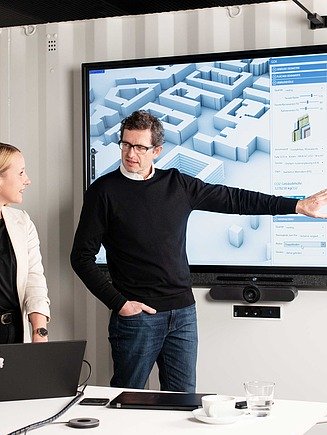How artificial intelligence supports our imagination

Generative design: innovative, networked, automated
Currently, the planning of structures is mostly based on a time-consuming manual process. For optimization purposes, only a few variants can be investigated due to time and cost constraints. Generative Design develops digital tools for planners to automate the design of buildings. It is a software-based method to develop a large number of design or construction proposals in a very short time. Our engineers and architects first define a goal and then "feed" the Generative Design application with various data about the proposed project (e.g., site area, building code, construction type). With the help of an algorithm that uses artificial intelligence, the software automatically calculates a variety of solutions - even in the case of conflicting requirements such as energy efficiency and construction costs.
So how does a generative design process work? Planning tasks are always individual, but they follow the same rules. Together with the planners of the STRABAG Group, we convert traditional design processes into software through programming. Planning steps can now be executed automatically by the planners and optimized using evolutionary methods. In this way, not only a few, but many variants can be generated and optimal solutions can be searched for automatically.
Generative Design is used in various subject areas: e.g. in civil engineering for the optimization of shoring walls, in structural engineering for the automated planning of standard staircases or the creation of optimal energy concepts. Basically, Generative Design can be applied to any clearly describable design. Some Generative Design tools are already an integral part of our planning processes, such as Generative Design Energy. It enables our planners to interactively design and evaluate building services equipment in real time. This makes it possible to quickly and easily identify potential for increasing efficiency in both new and existing buildings. Other Generative Design tools are still under development or in pilot application. Generative Design already supports us in our work and will be an indispensable part of everyday project work in the future.
Different AI software solutions have been used for some time in product design, for example, but Generative Design is still young in the construction industry. But we are already seeing how our planning and construction processes are changing. Thanks to the software, we can calculate an almost unlimited number of parameters and options. This would be impossible to do manually. This opens up new possibilities, because our often preconceived design decisions are being questioned. Even the most creative planners have developed their style over years and subconsciously discard many alternatives before drawing the first line. With Generative Design, we turn the process around: we let the algorithm decide, without bias, what an optimal building might look like.
Using such a tool not only saves significant time. It may also produce solutions that might never have been discussed in the conventional design process. Of course, our Generative Design tools also focus on sustainability. In addition to parameters such as daylight quality and energy efficiency, Generative Design can be used to generate, analyze and optimize a wide range of sustainability metrics. For example, theCO2 footprint of the building can be calculated in the early phase and integrated into the decision-making process.
The Generative Design Team is a hybrid of STRABAG Innovation & Digitalization (SID) and Central Technology (ZT). The development of new tools is carried out by SID together with the architects and engineers of ZT and with the active support of the operational units. The application of the existing generative design tools is implemented by Central Engineering, which bundles the planning expertise of the Group, as well as by the operational development partners.
What makes our work so exciting is the close and interdisciplinary cooperation with the various project participants with always new challenges that a construction project brings. In advising our clients, we see a great responsibility for our environment and the building of tomorrow. Sustainable planning decisions are complex and often require an evaluation of conflicting criteria.
Generative Design tools provide an optimal complement to our planning and consulting services portfolio. There is enormous potential, especially in the early performance phases. With Generative Design, a large number of variants can be analyzed quickly and specifically and stored with essential key figures. In this way, we can offer our customers a secure and sustainable basis for decision-making at an early stage.
Our goal is to be the strongest force in building a better future. Technologies such as Generative Design will help us achieve this goal. If we use innovative applications in a targeted way, we can make building more sustainable, safer and more efficient in the future.


